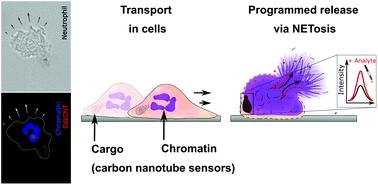Our official English website, www.x-mol.net, welcomes your feedback! (Note: you will need to create a separate account there.)
Transport and programmed release of nanoscale cargo from cells by using NETosis.
Nanoscale ( IF 6.7 ) Pub Date : 2020-04-30 , DOI: 10.1039/d0nr00864h Daniel Meyer 1 , Saba Telele , Anna Zelená , Alice J Gillen , Alessandra Antonucci , Elsa Neubert , Robert Nißler , Florian A Mann , Luise Erpenbeck , Ardemis A Boghossian , Sarah Köster , Sebastian Kruss
Nanoscale ( IF 6.7 ) Pub Date : 2020-04-30 , DOI: 10.1039/d0nr00864h Daniel Meyer 1 , Saba Telele , Anna Zelená , Alice J Gillen , Alessandra Antonucci , Elsa Neubert , Robert Nißler , Florian A Mann , Luise Erpenbeck , Ardemis A Boghossian , Sarah Köster , Sebastian Kruss
Affiliation

|
Cells can take up nanoscale materials, which has important implications for understanding cellular functions, biocompatibility as well as biomedical applications. Controlled uptake, transport and triggered release of nanoscale cargo is one of the great challenges in biomedical applications of nanomaterials. Here, we study how human immune cells (neutrophilic granulocytes, neutrophils) take up nanomaterials and program them to release this cargo after a certain time period. For this purpose, we let neutrophils phagocytose DNA-functionalized single-walled carbon nanotubes (SWCNTs) in vitro that fluoresce in the near infrared (980 nm) and serve as sensors for small molecules. Cells still migrate, follow chemical gradients and respond to inflammatory signals after uptake of the cargo. To program release, we make use of neutrophil extracellular trap formation (NETosis), a novel cell death mechanism that leads to chromatin swelling, subsequent rupture of the cellular membrane and release of the cell's whole content. By using the process of NETosis, we can program the time point of cargo release via the initial concentration of stimuli such as phorbol 12-myristate-13-acetate (PMA) or lipopolysaccharide (LPS). At intermediate stimulation, cells continue to migrate, follow gradients and surface cues for around 30 minutes and up to several hundred micrometers until they stop and release the SWCNTs. The transported and released SWCNT sensors are still functional as shown by subsequent detection of the neurotransmitter dopamine and reactive oxygen species (H2O2). In summary, we hijack a biological process (NETosis) and demonstrate how neutrophils transport and release functional nanomaterials.
中文翻译:

使用NETosis从细胞中运输和程序释放纳米级货物。
细胞可以吸收纳米级材料,这对于理解细胞功能,生物相容性以及生物医学应用具有重要意义。纳米级货物的受控摄取,运输和触发释放是纳米材料生物医学应用中的重大挑战之一。在这里,我们研究了人类免疫细胞(嗜中性粒细胞,嗜中性粒细胞)如何吸收纳米材料,并对其编程以使其在一定时间后释放这种货物。为此,我们让嗜中性粒细胞在体外吞噬吞噬酶DNA功能化的单壁碳纳米管(SWCNT),该碳纳米管在近红外(980 nm)处发出荧光,并用作小分子的传感器。摄取货物后,细胞仍会迁移,遵循化学梯度并对炎症信号作出反应。要发布程序,我们利用嗜中性粒细胞胞外陷阱形成(NETosis),这是一种新型的细胞死亡机制,可导致染色质肿胀,随后细胞膜破裂和细胞全部成分释放。通过使用NETosis的过程,我们可以通过初始浓度的刺激物(如佛波12-肉豆蔻酸13-乙酸盐(PMA)或脂多糖(LPS))来编程货物释放的时间点。在中间刺激下,细胞继续迁移,遵循梯度和表面提示约30分钟,直至数百微米,直到它们停止并释放SWCNT。如随后检测到神经递质多巴胺和活性氧(H2O2)所示,运输和释放的SWCNT传感器仍然起作用。综上所述,
更新日期:2020-04-03
中文翻译:

使用NETosis从细胞中运输和程序释放纳米级货物。
细胞可以吸收纳米级材料,这对于理解细胞功能,生物相容性以及生物医学应用具有重要意义。纳米级货物的受控摄取,运输和触发释放是纳米材料生物医学应用中的重大挑战之一。在这里,我们研究了人类免疫细胞(嗜中性粒细胞,嗜中性粒细胞)如何吸收纳米材料,并对其编程以使其在一定时间后释放这种货物。为此,我们让嗜中性粒细胞在体外吞噬吞噬酶DNA功能化的单壁碳纳米管(SWCNT),该碳纳米管在近红外(980 nm)处发出荧光,并用作小分子的传感器。摄取货物后,细胞仍会迁移,遵循化学梯度并对炎症信号作出反应。要发布程序,我们利用嗜中性粒细胞胞外陷阱形成(NETosis),这是一种新型的细胞死亡机制,可导致染色质肿胀,随后细胞膜破裂和细胞全部成分释放。通过使用NETosis的过程,我们可以通过初始浓度的刺激物(如佛波12-肉豆蔻酸13-乙酸盐(PMA)或脂多糖(LPS))来编程货物释放的时间点。在中间刺激下,细胞继续迁移,遵循梯度和表面提示约30分钟,直至数百微米,直到它们停止并释放SWCNT。如随后检测到神经递质多巴胺和活性氧(H2O2)所示,运输和释放的SWCNT传感器仍然起作用。综上所述,



























 京公网安备 11010802027423号
京公网安备 11010802027423号